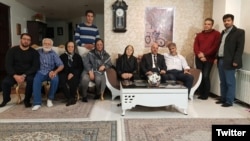The twenty-seven-year-old Pooya Bakhtiari was shot in the head on November 17 while protesting peacefully against higher gasoline prices alongside his mother and sister in Karaj. The government says they will pay blood money to the families of non-violent protesters like Pooya who were killed by security forces. But Pooya's mother says she will never accept blood money for her son.
Iran's Supreme National Security Council received Khamenei's permission this week to pay blood money to the families of non-violent protesters who were killed by the security forces in the recent protests. Those who were not involved in the protests and lost their lives in the crossfire will be considered as "martyrs" and their families will receive benefits, authorities say.
Paying blood money to the family of a victim by those responsible for the killing is an Islamic tradition. But Pooya's mother says even millions in blood money cannot bring her son back to life. "Every drop of my son's blood was worth millions," she told Radio Farda today.
Despite the threats and intimidation of the regime to silence the families of the victims of the recent protests, Pooya's parents and the families of other young people killed by the Iranian security forces over the years are not relenting.
Some of these families have been speaking to the media based outside Iran and are using the social media to tell Iranians and the world about the unfair killing of their children so they will not be forgotten, and their killers are punished someday.
Pooya's mother who is a teacher said the Intelligence Unit of the Education Ministry summoned her two days ago to intimidate her. Mrs. Bakhtiari who witnessed her son's death is very outspoken. She is one of the first among family members of victims who has been talking to the media abroad about her son's murder.
Mrs. Bakhtiari calls her son a "national hero" who "sought freedom, justice and truth”, but authorities are incapable of granting these to the people.
Pooya's father, who owns a small business that his son ran, fought in the Iran-Iraq war of the 1980s for five years. He and his family have been refusing to conciliate with or accept the sympathy of the authorities who they believe gave the order to shoot the protesters. But today Mr. Bakhtiari posted a picture of the exiled Crown Prince of Iran, Reza Pahlavi on his Instagram page and thanked him for contacting the family and offering condolences as have many relatives, friends and activists.
That is a big risk the family is taking, as any positive expression about the former royal family is equal to treason for the Islamic Republic.
Mr. Bakhtiari has also posted pictures of his son and the other victims of the crackdown.
In 2009 the regime employed similar tactics to silence the families of the victims of the protests against a disputed election and offered money to some families. The family of the twenty-six-year-old Neda Agha-Soltan who was shot by the Basij militia while protesting peacefully on June 10, 2009 was among them. The authorities in 2011 tried to bribe Neda's family with money, promises to find her killer and even a gift from Khamenei himself to keep quiet.
Neda's mother tells Radio Farda they returned the gift, a vase signed by Khamenei, untouched. "I told the judge 'I didn't want the blood money, I wanted my child's murderer to be found," she says and adds: "It’s eight years since then and I'm still waiting."
Neda became a symbol of the brutality of the Iranian regime when footage of her last moments was shown on television screens all over the world.The Times said it was "probably the most widely witnessed death in human history".
Iranian authorities learned a good lesson in 2009. This time when the protests spread throughout the country, they shut down the Internet to stop footage of their brutal crackdown on the protesters from reaching the media abroad. The Internet could not be permanently shut down, so ultimately information, pictures and videos of the bloody crackdown are now becoming more available to everyone.






